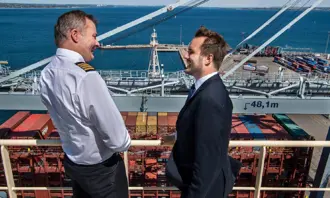Weathering the Storm
The Danish merchant fleet operates in all kinds of weather. And to be honest, we must say that in the last year we have needed all the manoeuvrability that the industry has acquired over the years.
Although 2019 was more changeable than has been the case for many years, early in 2020 the weather suddenly changed, and we faced a fierce storm with the corona crisis. We have not yet come through the storm, but Danish shipping companies have demonstrated their skills and responsibility by sailing on through the crisis, and helping to maintain vital supply lines. I believe that many people have had their eyes opened to the fact that 90% of world trade is transported by sea, and 75% of Denmark's imports arrive by ocean highways.
However, it has not all been about high waves: the sun has also shone on Danish shipping. Shipping under the Danish flag has once again set a record. At year-end, 731 vessels were flying the Danish flag, Dannebrog, at the stern. This is 21 more than the preceding year. And with the expansion of the Danish International Register of Shipping (DIS), and the tonnage tax scheme, after several years' hard work, the new offshore activities now come under the Danish flag. These first flaggings give hope that even more will sign up in the future and hoist the Danish flag at their stern.
Danish export maritime transport has never been as great as in 2019, when exports totalled more than DKK 207 billion. An impressive result, generated despite trade war, Brexit and an unstable situation in the Middle East.
At the start of the year, the entire industry showed that it was ready to take another step in a green direction as the new global sulphur requirements for ship fuel came into effect. The transition has gone well, and thorough preparation meant that, as usual, we have sailed safely through the challenges.
This year, it has also been definitively stated that Blue Denmark is part of the climate solution. We are by far the most CO2-friendly mode of transport with the lowest emissions in relation to freight volumes, but it is no secret that the industry emits a significant amount of CO2 overall.
Therefore, it was natural that Blue Denmark was given one of the government's 13 climate partnerships. The work has been targeted, and in March we delivered a number of initiatives and recommendations, aimed both at contributing to the target of a 70% reduction in Denmark by 2030, and a reduction of global CO2 emissions from shipping, given that over 95% of Danish shipping takes place outside Denmark's borders. Danish Shipping and the Danish Ferry Association have also signed up to the goal of CO2 neutrality – without climate compensation – by 2050.
We have also been able to address a challenge that so far has received inadequate attention. Gender distribution is skewed, and we do not have enough women in our industry. At the same time, we both want and lack well-qualified workers. Therefore, Danish Shipping has been working to get more women into shipping, and the shipping companies have backed this right from the start. The first 24 shipping companies were quick to sign the ”Charter for more women in shipping” at its launch in January, and we are constantly working to get more shipping companies on board.
The weather forecast for the coming year warns of winds from changing directions. The climate recommendations are to become a sector roadmap, which we await with anticipation. And in the near future, the short-term climate targets must be adopted by IMO. Finally, the repercussions of the corona crisis may well last far into the future.
Danish shipping will probably ride the storm, and with a firm hand on the tiller, we will sail on with solutions and with optimism.
Jacob Meldgaard, Chairman of Danish Shipping
Danish export maritime transport has never been as great as in 2019, when exports totalled more than DKK 207 billion. An impressive result, generated despite trade war, Brexit and an unstable situation in the Middle East.
The Year in Brief
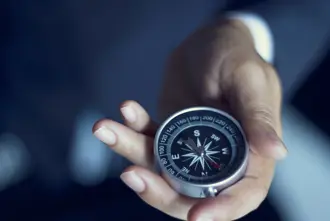
Status på dansk skibsfart

Year in Numbers
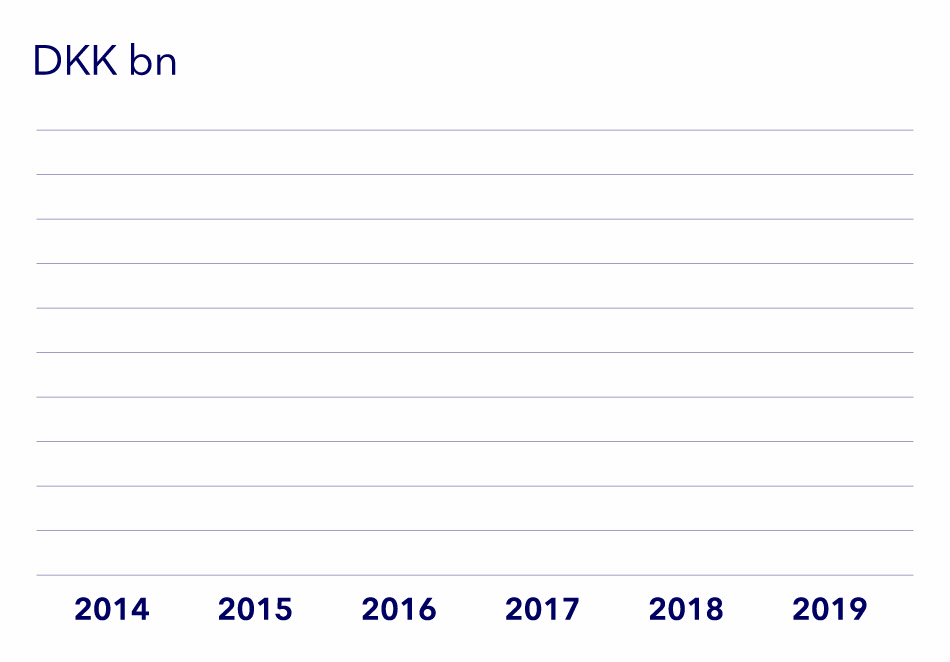
Biggest Export Industry in Denmark
2019 proved a record-setting year, with Danish shipping companies exporting goods worth more than DKK 207 billion, an increase of 3.9 percent from 2018.
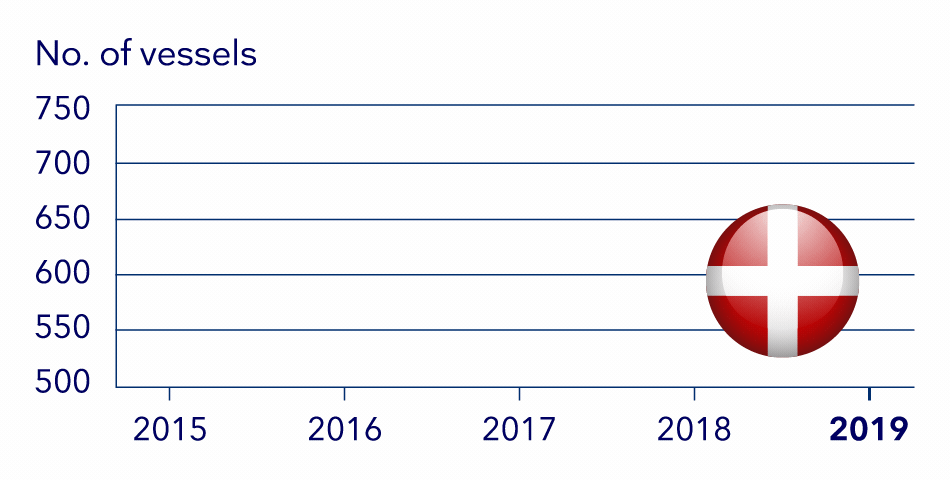
Increase in Danish-flagged vessels
The merchant fleet sailing under the Danish flag has grown over the last 10 years. At the end of 2019, a total of 731 vessels with a gross tonnage (GT) of 21.3 million were flying the Danish flag.
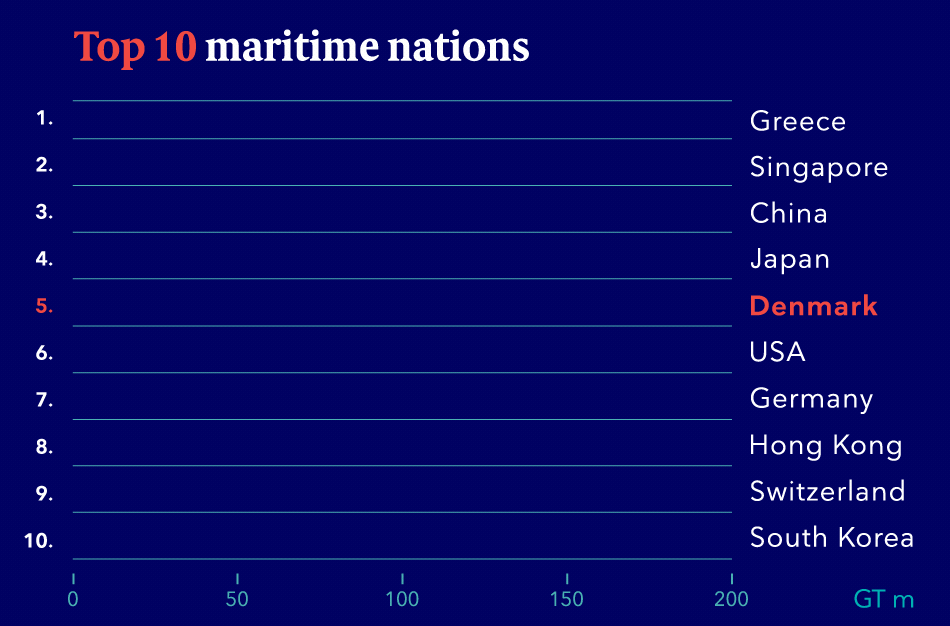
Fifth largest shipping nation
This positive development means that Denmark has now passed the United States as the world's fifth largest shipping nation in terms of gross tonnage of Danish-operated ships, both Danish- and foreign-flagged. Looking at the merchant fleet under the Danish flag alone, Denmark ranks 12th in the world (GT).

Climate and the environment
Ambitions
In 2019, the climate really emerged onto the political agenda. The newly-appointed government in Denmark set an ambitious target of a 70% reduction in CO2 emissions by 2030; a goal that has since gained wide support in the Danish Parliament. Before the New Year, the European Commission also presented an ambitious climate plan for a 50% reduction by 2030, and CO2 neutrality by 2050.
In response to the global climate challenge, Danish Shipping and the Danish Ferry Association chose to sign up to the target of CO2 neutrality, without climate compensation, by 2050. Shipping must contribute to reducing CO2 emissions in both the short and the long term. This requires us to focus on research and development of new technologies and fuels for the CO2-neutral shipping of the future.
Climate initiatives up to 2030
By 2030, shipping must be 40% more efficient compared to 2008. It requires rules and legislation to achieve the goal, and these rules need to be enforced in all countries. This is what Danish Shipping is working towards in IMO. In addition, it has to be up to the individual shipping company as to how it will achieve its goals. Whether it involves adjusting the engine power, optimising sailing or something else, the company must be able to decide for itself.
Our climate ambitions
Shipping is already the most energy-efficient mode of transport over long distances when compared, for example, with air transport and lorries. Driving just one kilometre by car emits the same amount of CO2 as transporting one pair of shoes from Asia to Europe. In other words, shipping is a CO2-friendly way of transporting goods from A to B. The relatively large CO2 footprint of shipping is a consequence of most of the world's goods being transported by sea.
The climate partnership
In November 2019, the Danish government initiated 13 climate partnerships, through which all industrial sectors were to submit their proposals for initiatives and recommendations for the government's climate goals. Søren Skou, CEO of A. P. Møller – Mærsk A/S, was appointed chair of the climate partnership for Blue Denmark, and Danish Shipping hosted the secretariat function.
In December, over 150 players from all over Blue Denmark came together at a workshop, where everyone gave their take on challenges, opportunities and solutions for the CO2 reduction. This resulted in 21 initiatives and recommendations to the government on how Denmark can best support a sustainable change in shipping, at both national and international levels.
The climate partnership for Blue Denmark submitted its report, "Vejen mod en mere klimavenlig skibsfart" ("The road to more climate-friendly shipping"), in March 2020.
Global sulphur regulations
As a result of thorough preparation and planning, shipping companies have made a successful transition to the global sulphur requirements that came into force on 1 January 2020. Danish Shipping will keep an eye on how the regulations are being enforced around the world in the coming years, to ensure that the regulations are implemented uniformly and effectively.
Discharge of wash water from flue gas cleaning equipment (scrubbers) on ships was on the IMO agenda, and an increasing number of local bans on the use of this technology came to fruition in 2019 and 2020. Danish Shipping continues to work to ensure that decisions about bans are made on a scientific basis, and that shipping companies that have installed the approved technology are not penalised by new regulations.
Scrapping
India and Turkey ratified the Hong Kong Convention in 2019, which means that only one major dismantling country is left before this comes into force. Danish Shipping continues to support active efforts to raise the standard of the Indian facilities to ensure a wide range of responsibly-run facilities. The EU inspected several Indian scrapping facilities for inclusion in the EU list of approved facilities. Despite the hard work that the scrapping facilities have done to improve the working environment and environmental conditions, they were unfortunately not included on the list, which is continuously being updated.
Global fund for CO2-neutral shipping
CO2-neutral shipping requires the development and promotion of new technologies and fuels. The shipping industry is prepared to contribute, and therefore a combined global industry submitted a proposal to IMO in December 2019 to establish an industry-funded global fund for research and development in green fuels. The proposal will create a fund of USD 5 billion over a 10-year period.

International trends
Coronavirus
Like a bolt from the blue, the coronavirus struck us all in the first months of 2020. As the world closed down, and ferries said goodbye to the majority of passengers, the merchant fleet sailed on to continue to provide vital supplies of food, medicine and other goods. The shipping companies have assumed a great responsibility to keep the propellers in the water in a difficult time. Changing crews has become more difficult, consumer confidence is declining, and varying degrees of direct state aid to shipping companies and shipyards around the world risk distorting competition. The corona crisis means we can easily conclude that operating shipping companies has become more challenging in 2020 than it was in 2019.
Trade war
Before the corona crisis hit, trade tensions between the USA and China were creating uncertainty in the global shipping market. The trade war between the world's two largest economies has been fierce, and the conflict has threatened to drag the entire world economy into a recession. In December 2019, the USA and China entered into a partial agreement on trade between the two countries, in a temporary de-escalation of the trade war.
Brexit
The future relationship between Britain and the European Union (EU) due to Brexit remains unclear. What is certain is that the UK has officially left the EU, but the partnership agreement and the underlying EU-UK trade agreement have not been negotiated. This creates unproductive uncertainty for Danish shipping companies, which, with exports of DKK 9.4 billion in 2018, have the United Kingdom as their third largest market. They have a great interest in an orderly relationship, which, among other things, ensures continued access to the major UK market for offshore wind energy.
Piracy
Piracy continues to pose a threat to the safety of crews and ships, even though the total number of pirate attacks shows a slight decline in 2019 compared to 2018. More than anything, the challenge is that kidnappings in the Gulf of Guinea increased significantly in 2019, when 121 seafarers were kidnapped. This is an increase of more than 50% compared to the 78 kidnappings in 2018. In addition, there were particularly severe attacks off more countries in the latter half of 2019, and further from the coast than before.
The piracy situation in the Gulf of Guinea must be taken seriously, and the current ‘normal state’ is totally unacceptable. Following requests from Danish Shipping, amongst others, the Danish authorities raised the level of security in the region. Danish Shipping, in collaboration with our international shipping organisations, will urge the Danish and European decision-makers to take more steps to protect crews and international shipping interests against pirate attacks in the waters off the coast of West Africa.
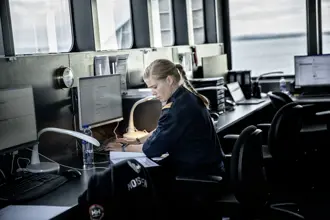
Labour market and skills
More women in shipping
Loads of diversity is to be found among Danish shipping companies, except when it is to do with women. Women employed by Danish shipping companies total 16% of the workforce. Of seafarers on Danish-flagged ships, only 8% are women. If ferries are excluded, only 2% of seafarers on Danish-flagged vessels are women. This skewed gender distribution was the reason why Danish Shipping threw itself into the fight to recruit more women into shipping.
Danish Shipping’s taskforce for more women at sea was set up in the autumn with 10 recommendations for the industry. These ranged from advice about setting targets for the percentage of women in companies to cleaning up language and prejudices. In January, a "charter for more women in shipping" was launched together with the Minister for Equal Opportunities, Mogens Jensen, and there was support from the shipping companies from the first moment. Now 24 shipping companies have signed the charter, which requires them to set specific targets and embed the work within senior management.
At the end of the year, we are taking stock, and we hope that at least 75% of the members of Danish Shipping will be signing up to the charter.
Guaranteed internships
Access to internships is a prerequisite for training engineers, navigators, ship assistants and ship mechanics for the shipping companies. Danish Shipping has guaranteed internships corresponding to 350 full-time equivalents per year to strengthen and ensure skills for the future. The internship guarantee has meant that an entire industry has put education on the agenda. Thus, in 2019, a number of shipping companies were approved as internship companies, and in this way more internships were generated for the basic maritime education programmes. They provided a total of 379 full-time equivalent internships.
Collective bargaining
Agreement was successfully reached on the renewal of all Danish Shipping's agreements for ratings with an expiry date of 1 March. The prevailing themes, in addition to pay increases, were the adaptation of the agreements to the new holiday law, earmarked parental leave, and strengthening of the role of health and safety representatives. The three-year renewal was strongly influenced by the fact that the financial results in the general labour market were at the top end, with increases well over the previous three-year period. Nevertheless, the result in Danish Shipping's area as a whole is considered to be the best that could be achieved at the time. The fact that the situation changed significantly shortly afterwards as a result of COVID-19 did not affect the settlement that had already been agreed, but has led to the postponement of negotiations for the renewal of the officers' agreements expiring on 1 April.
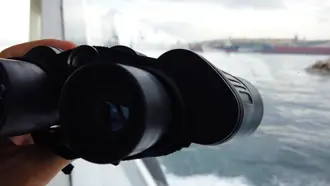
Towards new destinations
CO2 reduction
Reducing shipping's CO2 footprint will remain high on the agenda. The 2030 target in IMO's climate strategy must be translated into legislation that can take effect from 2023. It is important that both technical and operational improvements be considered, and that the regulations can be enforced at the same time. In addition, the focus must be on the development and innovation of new, green and climate-neutral fuels in order to achieve the strategy's emission targets for 2050. An industry-funded global research and development fund will be an important means for achieving this goal. The transition that shipping will have to undergo by 2050 will require cross-sector thinking and with a particular focus on energy infrastructure.
The increased focus on climate impact has also become a theme when obtaining financing for shipping companies. A number of shipping banks support the Poseidon Principles, which measure the banks' loan portfolios against IMO's climate goals. The EU is developing regulations for what can be considered sustainable financing. It is crucial that shipping companies continue to have broad access to financing which at the same time supports a trend towards CO2-neutral shipping.
Enforcing the sulphur requirements
The global fuel requirements for ships' fuel have now been operating for over six months. It is important that the authorities around the world ensure that the requirements are met. We have gone to great lengths to ensure effective enforcement at home. This also needs to be the case outside Denmark.
Approved scrapping facilities
When a ship is to be scrapped, both the environmental and working conditions need to be in order. Scrapping must be done in a responsible way, whether in Denmark, India or Turkey. The EU list of approved scrapping facilities is constantly being updated, and it is essential that the list be expanded with additional facilities outside the EU, so that conditions continue to be improved. Danish Shipping is working towards the list including facilities in Alang, India, which has invested in environmental and safety improvements.
Brexit and international trade
Closer to domestic waters, the EU and the UK have yet to agree on the future trade relationship. The Danish maritime sector has strong interests here, including in offshore. Danish Shipping will fight for an agreement covering maritime transport. Free and equal market access for both national and international shipping must be ensured without reservations.
At worst, the corona crisis could lead to increased protectionism and economic nationalism. This is a development that would not be beneficial to shipping. It is important that, in both Denmark and in the EU, we stand guard for an agenda for international trade which strikes the right balance between open and fair trade. Danish Shipping will continue to work to ensure that measures to protect against unwanted foreign investment do not become a back door to general protectionism.
Furthermore, we are focusing on ensuring that there is no competition-distorting state aid, as we have seen in South Korea. There must be equal competition, not least when the market is under pressure.
The situation at home
The industry has been looking forward to finally implementing the extension of the Danish International Register of Shipping (DIS) and the tonnage tax scheme. Both schemes have been approved by the European Commission on special terms. It is therefore crucial to ensure dialogue with shipping companies and authorities on the implementation and interpretation of the schemes, so that the expansion creates even more activity under the Danish flag.
With Blue Denmark as one of the 12 national positions of strength in a new business promotion system, a unified national maritime cluster must be established to strengthen the maritime companies' innovation, cooperation and internationalisation, based in all parts of Denmark.


